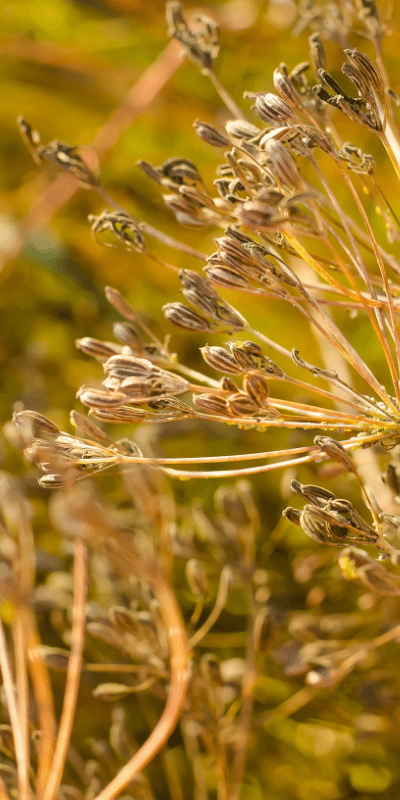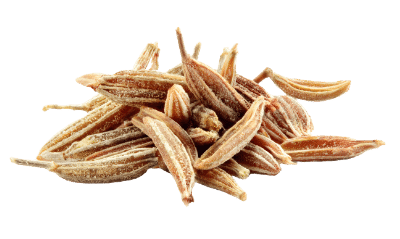
Health
benefits
Cumin seeds are a rich source of nutrients. They are high in fibre, and minerals such as calcium, iron, magnesium, and phosphorus. Cumin also contains beta-carotene, and vitamin B3 (also known as niacin). What are these good for?
- Calcium supports proper muscle function and contributes to healthy skin.
- Iron helps maintain cognitive function and a normal immune system.
- Magnesium helps reduce fatigue, supports proper muscle function and maintains normal bone structure.
- Phosphorus helps maintain normal bone structure and healthy teeth, and supports energy metabolism.
- Beta-carotene is a precursor to vitamin A, which is vital to iron metabolism, healthy skin, good vision, and a properly functioning immune system.
As it is usually ingested in very small quantities, cumin is not a miracle food. It can nevertheless be part of a healthy diet.
Nutritional
value
The best time
to eat cumin
Seeds are harvested from June to October, and are available all year round.
Vegetable garden
or balcony
Its leaves are 3-7 cm (2-4 in.) long, spindly, and yellowish-green in colour. It produces umbels of white to pinkish flowers in July.
It requires full sun, and does best in warm, fertile, well-drained soil. Soil must remain moist. Since cumin does not transplant well, it is best to sow seeds directly in the garden in May. It does not do as well in a pot and will not produce as many seeds, but feel free to give it a go!
Seeds mature usually 3-4 months after being sown (pods should readily open); their colour will change from green to brown. To harvest cumin seeds, cut stems with seedpods close to the base as soon as the colour of the seeds has changed from green to brown. Hang stems upside down in a well‑ventilated and dry area. Place a container underneath to catch seeds that fall. After a few days, tap and shake the pods to release the remaining seeds.
Sorting
and storage
Once the seeds are dry, they can be kept in airtight containers or in paper bags for many months. Ground seeds lose flavour rather quickly.
Ensure the seeds are completely dry; they should vary from khaki to brown in colour. Cumin seeds are best preserved whole. Grinding right before use will ensure more flavour.
Tips and tricks
in the kitchen
Cumin has a warm, tangy flavour.
When heated, its flavour becomes slightly bitter and more peppery. Add whole or ground seeds into raw or cooked dishes. Spice blends such as ras el hanout or mixes for tajines contain cumin.
Add it to traditional recipes such as chili con carne, tajines and couscous. Cumin goes well with cheeses too, such as the Dutch cheeses Edam, Gouda and Munster. Like most spices, it can also be added to herbal teas.
Add it to traditional recipes such as chili con carne, tajines and couscous. Cumin goes well with cheeses too, such as the Dutch cheeses Edam, Gouda and Munster. Like most spices, it can also be added to herbal teas.
Environmental
impact
Cumin’s PEF score (Product Environmental Footprint) should provide us with more information! PEF scores are calculated by Agribalyse*. They are based on the life cycle assessment of a plant: How is it grown? What is the environmental impact of its transport and transformation? The lower the score, the lesser the impact.
- Cumin seeds: 1.32
- Raw beef steak: 2.77
*Data from the Agribalyse database, a database that compiles the environmental scores of food products. The unique score, a weighted average of 16 indicators, is calculated according to the European PEF methodology. It is not environmental labelling or an eco-score.
CO2 equivalent for 100 g of cumin seeds: 0.815 kg of CO2-eq (the same as 24 g of raw beef steak).

An acquired taste
Cumin’s pronounced flavour may be an acquired taste to some. Add it in small doses in cold or hot dishes so that people can try it. It is a favourite in creamy carrot and cumin soup.
No need for complicated recipes: cumin goes well with roasted chicken, homemade hummus, meatballs and falafels. You can even use it to enhance the flavour of a fruit salad. Also delicious with fresh goat cheese.
Where does cumin come from?
Origins of cumin and its varieties
Cumin is native to the Orient. It may sometimes be confused with caraway, the fruit (or seeds) of which form in a similar fashion after the flowers blossom.



 Rye
Rye  Lentils
Lentils  Plant Diseases, Garden Pests, and Possible Treatments
Plant Diseases, Garden Pests, and Possible Treatments 









